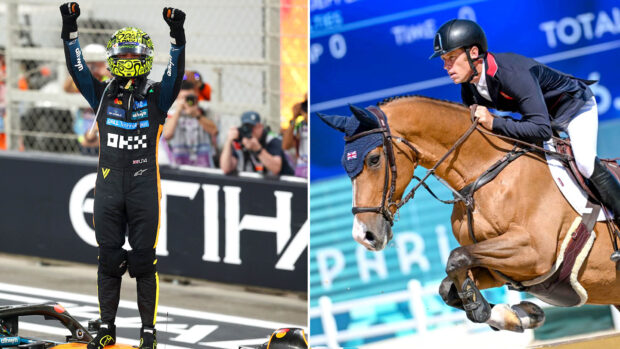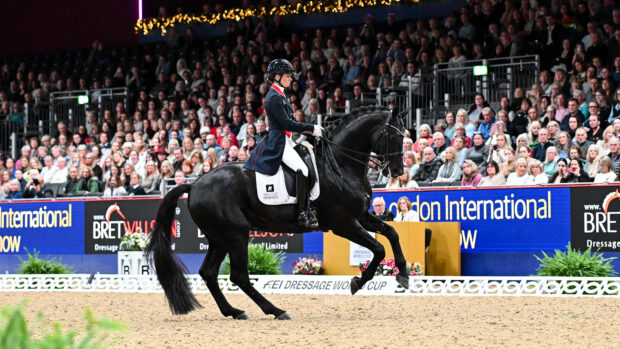World, European and Olympic medallist Laura Tomlinson on the importance of teaching and maintaining relaxation in dressage horses
WITH relaxation in dressage horses taking centre stage as part of this week’s dressage special issue of Horse & Hound magazine (turn to p30, on sale Thursday 17 March), I wanted to add my thoughts on the topic.
As one of the key aspects in the scales of training, it should seem an obvious prerequisite for “good” dressage, yet it is actually harder to achieve than one might think. At the higher levels, our horses are expected to move, in the words of my father, “like the earth is on fire”, and yet have the calmness to execute a test with laser precision.
It is all too easy to lose that illusive relaxation along the way of teaching horses the balance and explosiveness they need for plus-70% scores at grand prix.
Sadly, a lot of horses don’t even begin with relaxation in their early years, with too much emphasis being placed on how spectacular they need to be to win young horse classes. But if a horse never learnt it at the start of its training, then it becomes harder to teach later in life. A horse with solid foundations in the scales of training will always find it easier to fall back on these basics.
My 12-year-old chestnut grand prix horse Fallatijn, (Finn) really struggles with relaxation in the ring. We call him “super sloth” because he goes from being so chilled that he’s like a sloth, to a Ferrari on ice, with all the power but no traction.
It is a real process for me now to get him out often in different arenas and give him lots of positive experiences so that he learns to take a breath and stay relaxed, even in the movements for which he has to use all his power.
I have had Finn since he was six and he was always a wild child, especially in the ring. He would call for other horses and feel very worried on his own. He has improved so much but really, the relaxation is the crunch point for him; if we get it, I believe he will be a top team horse and if we don’t crack it, he will always just be on the cusp.
Different strengths
IT is very interesting watching different top horses and how they cope with their nerves and tension. Jessica von Bredow-Werndl’s Olympic champion TSF Dalera BB appears very relaxed and poised, whereas the likes of Isabell Werth’s multi-medallist Bella Rose or Cathrine Dufour’s European medallist Bohemian are more visibly tense horses.
This is positive tension that can be used to make the movements look exciting, but those two horses do appear more on the edge compared to Dalera, where everything looks very calm.
Different horses at the top level have different strengths and some riders prefer to be able to push the horse, whereas others would rather just sit and keep things calm. The key is to make things look effortless even if your horse is more of a ticking time bomb by nature. Once the horse has confidence in the rider and in itself, you can manage that tension as a positive rather than let it turn into stress.
It is so important that riders who manage this well are rewarded, but riders who are sitting on a visibly stressed horse with negative “tightness” in their tension do not get rewarded too much, even if the horse does a spectacular, mistake-free test.
To overlook this missing chunk of the scales of training leads to the sport of dressage going in the wrong direction, a direction that we cannot afford to go down. In this day and age of social media and internet commentary on everything, the backlash could become serious – as it should be for the sake of our generous animals.
• Do you agree with Laura? Let us know your thoughts at hhletters@futurenet.com
- Read this exclusive column, plus lots more in our dressage special issue of Horse & Hound magazine, on sale Thursday 17 March
You may also be interested in…

Who are the best dressage horses in the world right now? We take a look…

‘He’s not normal!’: Lottie Fry scores huge personal best with upcoming stallion

Olympic dressage champion reveals exciting news – but tilt at World Championships looks unlikely

Laura Tomlinson: ‘More can be done for female riders’

Subscribe to Horse & Hound magazine today – and enjoy unlimited website access all year round
Horse & Hound magazine, out every Thursday, is packed with all the latest news and reports, as well as interviews, specials, nostalgia, vet and training advice. Find how you can enjoy the magazine delivered to your door every week, plus options to upgrade your subscription to access our online service that brings you breaking news and reports as well as other benefits.




